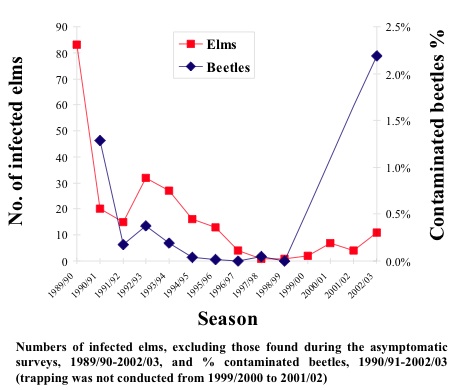PESTS AND DISEASES OF FORESTRY IN NEW ZEALAND
Dutch elm disease in Auckland 2002-03
Scion is the leading provider of forest-related knowledge in New Zealand
Formerly known as the Forest Research Institute, Scion has been a leader in research relating to forest health for over 50 years. The Rotorua-based Crown Research Institute continues to provide science that will protect all forests from damage caused by insect pests, pathogens and weeds. The information presented below arises from these research activities.
From Forest Health News 129, May 2003.
The Dutch elm disease eradication programme is being coordinated and funded by the Ministry of Agriculture and Forestry (MAF), supported by the local city councils. The campaign during the 2002-03 summer consisted of three disease detection surveys and a limited pheromone trapping programme. Surveys that were undertaken during the previous three seasons to determine the incidence of Ophiostoma novo-ulmi in inner growth rings of asymptomatic elm trees were discontinued in favour of reinstating the pheromone trapping programme (O. novo-ulmi is the fungus that causes Dutch elm disease).
As a result of the disease detection surveys infected trees were found at three locations - the eastern suburbs (Bleakhouse Road/Murvale Reserve, Howick); south Auckland (Catkin Crescent, Papatoetoe) and west Auckland (Waikumete Cemetery, Glen Eden). The fungus was isolated from one-year-old wood in the trees at Bleakhouse Road, and variously from current, one-year-old, and 4- to 5-year-old wood from the six infected trees found at Waikumete. Infected trees had been found at Bleakhouse Road and Waikumete Cemetery in previous seasons.
For the pheromone trapping programme 51 traps were deployed in five high risk areas (Pakuranga/east Tamaki, Remuera/Parnell, Howick/Bucklands Beach, Papakura, and Waikumete Cemetery in Glen Eden). In early March, 16 additional traps were placed at sites in west Auckland, Remuera, Papatoetoe, and Takanini. By 6 May a total of 3,514 beetles had been caught, of which 79 (2.2%) were contaminated by Ophiostoma novo-ulmi. Infective beetles were trapped at Waikumete Cemetery and Clayburn Reserve in Glen Eden, and Howick and Pakuranga.
The percentage of infective beetles caught was the highest since trapping began in 1990, outstripping the 1.3% trapped in 1990/91 (see Figure).

It was noteworthy that 95% of infective beetles were caught in the Waikumete Cemetery traps, where 75 of a total of 1,042 trapped beetles were found to be carrying the fungus. Infective beetles were first caught at Waikumete on 30 December, and not long after infected trees were found nearby. Trapping of infective beetles continued, and more infected elm trees were found near the cemetery in late January and February. Removal of all elm material was undertaken, but despite this, infective beetles were still being caught by the end of March. A special survey targeting the area was conducted and on 4 April an infected tree was found at an address approximately 200 m from one of the traps at the cemetery. This tree contained numerous live beetles and larvae and 90% of those sampled were contaminated by O. novo-ulmi. It is highly likely that this tree was a source for many of the contaminated beetles trapped.
The find of an infected tree during the targeted survey, which was prompted by the trapping of infective beetles, shows the value of the pheromone trapping programme. It is nonetheless disquieting that the infected tree was not found during the routine disease detection surveys, and demonstrates the critical need for these surveys to be carried out thoroughly and accurately. Provided they are performed properly, eradication is still possible.
(Lindsay Bulman and Margaret Dick, Forest Research)
This information is intended for general interest only. It is not intended to be a substitute for specific specialist advice on any matter and should not be relied on for that purpose. Scion will not be liable for any direct, indirect, incidental, special, consequential or exemplary damages, loss of profits, or any other intangible losses that result from using the information provided on this site.
(Scion is the trading name of the New Zealand Forest Research Institute Limited.)

 Farm Forestry New Zealand
Farm Forestry New Zealand

